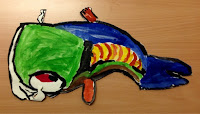Six thousand years ago evil stalks the land. Only twelve-year-old Torak and his wolf-cub companion can defeat it. Their journey together takes them through deep forests, across giant glaciers, and into dangers they never imagined.
In this page-turning, original, and spectacularly told adventure story, Torak and Wolf are joined by an incredible cast of characters as they battle to save their world.
Over the course of three one hour long lessons children were given the chance to draw wolves, create paintings and finally each make a wolf mask.
 |
| Sketches of wolves were made using different pencil shades. |
 |
| Paintings were created. Children learnt about different tones of grey by only using white and black paint. |
 |
| Wolf masks These were made in three stages... 1. The structure of the mask was a bought template, cardboard and lots of masking tape. 2. Paper mache-ing the entire mask. 3. Paint! |

Everyone could transform into a completely different character when they put on the wolf mask! They were used as part as drama lesson, class assembly dance and group games lesson.






























































